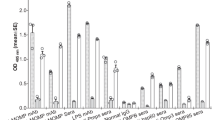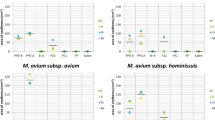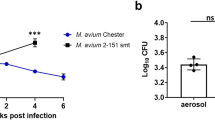Abstract
RECENTLY it was shown1 that mice develop resistance to pulmonary infection with virulent Mycobacterium tuberculosis (strain H37Rv) when attenuated tubercle bacilli (BCG or H37Ra) are administered either intravenously or by the aerosol method. Previously, several authors2,3 demonstrated that killed organisms suspended in mineral oil produce significant changes in experimental hosts and Choucron4 extracted a fraction (Pmko) with mineral oil to which various immunological activities were ascribed. Cell walls and cell wall extracts of a variety of micro-organisms have been found to produce resistance to infection in experimental animals although cytoplasmic particles rather than cell wall material have been implicated as the protective antigen of M. tuberculosis5,6. Since we had been unable to immunize mice either with cell walls of attenuated tubercle bacilli which had been ruptured in water or with the entire disruption product (mixture of cell wall and cytoplasm), investigations were initiated to test the potency of BCG bacilli disrupted in oil. This method was utilized by D. W. Smith and the material was reported to be highly immunogenic in guinea pigs (Conference on Immunity and Pathogenesis of Mycobacterial Diseases, U.S. National Institutes of Health, March 1962). The experiment described here shows that such products are capable of giving rise to significant protective immunity in mice injected intravenously with as little as 0.2 mg of material.
This is a preview of subscription content, access via your institution
Access options
Subscribe to this journal
Receive 51 print issues and online access
$199.00 per year
only $3.90 per issue
Buy this article
- Purchase on Springer Link
- Instant access to full article PDF
Prices may be subject to local taxes which are calculated during checkout
Similar content being viewed by others
References
Larson, C. L., and Wicht, W. C., Amer. Rev. Resp. Dis., 85, 833 (1962).
Saenz, A., and Canetti, G., La Presse Medicale, 42, 849 (1939).
Coulaud, E., Ann. Inst. Pasteur, 61, 355 (1938).
Choucron, N., Amer. Rev. Tuberc., 56, 203 (1947).
Youmans, G. P., Millman, G. P., and Youmans, A. S., J. Bact., 70, 557 (1955).
Kanai, K., and Youmans, G. P., J. Bact., 80, 607 (1960).
Larson, C. L., and Wicht, W. C. (unpublished results).
Nègre, L., Ann. Inst. Pasteur, 83, 429 (1952).
Author information
Authors and Affiliations
Rights and permissions
About this article
Cite this article
LARSON, C., RIBI, E., WICHT, W. et al. Resistance to Tuberculosis in Mice immunized with BCG disrupted in Oil. Nature 198, 1214–1215 (1963). https://doi.org/10.1038/1981214a0
Issue Date:
DOI: https://doi.org/10.1038/1981214a0
This article is cited by
-
Specific and nonspecific stimulation of resistance in mice against infection with mycobacterium tuberculosis H37Rv
Pneumonologie Pneumonology (1970)
-
Die Adjuvanswirkung von Mycobakterien
Klinische Wochenschrift (1966)
Comments
By submitting a comment you agree to abide by our Terms and Community Guidelines. If you find something abusive or that does not comply with our terms or guidelines please flag it as inappropriate.



